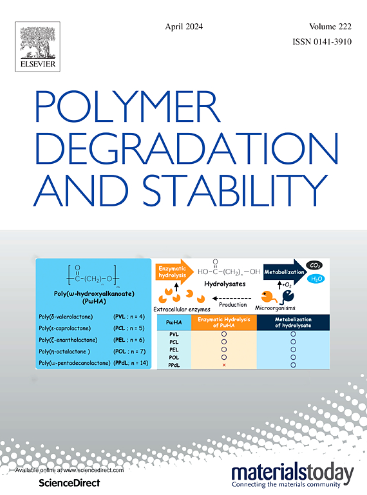Degradation behavior of nitrocellulose in imidazole aqueous solution
IF 6.3
2区 化学
Q1 POLYMER SCIENCE
引用次数: 0
Abstract
Nitrocellulose (NC)-based materials can take years to degrade considerably in nature. One of the most promising NC waste treatment methods is inorganic base hydrolysis. In this work, the degradation mechanism of NC in an aqueous solution of imidazole, an organic base, had been constructed. The results showed that imidazole can cause denitration, ring opening, and oxygen bridge breaking in NC; eventually, NC was completely degraded. In this process, the denitration of vicinal nitrates generated nitrite and carbonyl groups, while the denitration of isolated nitrates produced nitrate and hydroxyl groups. The molar ratio of nitrite to nitrate in the reaction solution increased from 2.77 to 4.44 and finally decreased to 1.97 with time. The reaction rate of the nitrate group and oxygen bridge at the early stages of the reaction was as follows: vicinal nitrate's denitrification > isolated nitrate's denitrification > oxygen bridge breaking. Moreover, imidazole's diffusion rate gradually decreased as the reaction progressed, eventually balancing with the rate for complete degradation of NC. Meanwhile, the degree of crystallinity of remaining NC gradually increased, whereas the nitrogen content and relative number-average molecular weight of remaining NC gradually decreased from 13.52 % and 139,212 to 11.57 % and 3721; they ultimately maintained balance. The apparent morphology of NC fibers changed as cracks initially formed, then cracks progressively enlarged to produce fiber fragments, and eventually NC vanished entirely in the solution. The degradation of NC by imidazole potentially supports the one-step biochemical treatment of NC waste.
硝基纤维素在咪唑水溶液中的降解行为
以硝化纤维素(NC)为基础的材料需要数年时间才能在自然界中大幅降解。无机碱水解法是最有前途的 NC 废料处理方法之一。这项研究构建了 NC 在有机碱咪唑水溶液中的降解机理。结果表明,咪唑能使 NC 发生变性、开环和氧桥断裂,最终使 NC 完全降解。在这一过程中,邻位硝酸盐的变性产生亚硝酸基和羰基,而孤立硝酸盐的变性则产生硝酸基和羟基。随着时间的推移,反应溶液中亚硝酸盐与硝酸盐的摩尔比从 2.77 升至 4.44,最后降至 1.97。在反应初期,硝酸基团和氧桥的反应速率为:硝酸根脱硝>;硝酸根脱硝>;氧桥断裂。此外,随着反应的进行,咪唑的扩散速率逐渐降低,最终与 NC 的完全降解速率相平衡。同时,剩余 NC 的结晶度逐渐增加,而剩余 NC 的含氮量和相对平均分子量则从 13.52% 和 139,212 逐渐下降到 11.57% 和 3721,最终保持平衡。NC 纤维的表观形态发生了变化,最初形成裂缝,然后裂缝逐渐扩大,产生纤维碎片,最后 NC 完全消失在溶液中。咪唑对 NC 的降解为一步法生化处理 NC 废物提供了潜在支持。
本文章由计算机程序翻译,如有差异,请以英文原文为准。
求助全文
约1分钟内获得全文
求助全文
来源期刊

Polymer Degradation and Stability
化学-高分子科学
CiteScore
10.10
自引率
10.20%
发文量
325
审稿时长
23 days
期刊介绍:
Polymer Degradation and Stability deals with the degradation reactions and their control which are a major preoccupation of practitioners of the many and diverse aspects of modern polymer technology.
Deteriorative reactions occur during processing, when polymers are subjected to heat, oxygen and mechanical stress, and during the useful life of the materials when oxygen and sunlight are the most important degradative agencies. In more specialised applications, degradation may be induced by high energy radiation, ozone, atmospheric pollutants, mechanical stress, biological action, hydrolysis and many other influences. The mechanisms of these reactions and stabilisation processes must be understood if the technology and application of polymers are to continue to advance. The reporting of investigations of this kind is therefore a major function of this journal.
However there are also new developments in polymer technology in which degradation processes find positive applications. For example, photodegradable plastics are now available, the recycling of polymeric products will become increasingly important, degradation and combustion studies are involved in the definition of the fire hazards which are associated with polymeric materials and the microelectronics industry is vitally dependent upon polymer degradation in the manufacture of its circuitry. Polymer properties may also be improved by processes like curing and grafting, the chemistry of which can be closely related to that which causes physical deterioration in other circumstances.
 求助内容:
求助内容: 应助结果提醒方式:
应助结果提醒方式:


